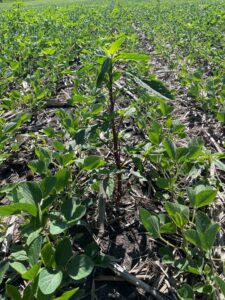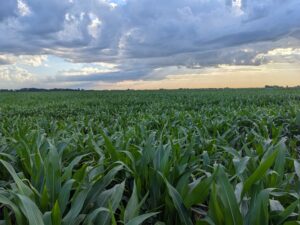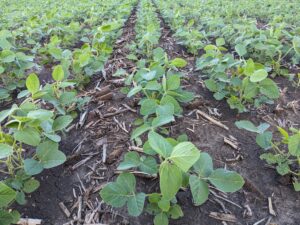Illinois Crop Update – June 14, 2024
Nicole Haverback – Watershed Outreach Associate
Henry County
Corn stages range from VE- V7, with bean stages similar. Most corn herbicide applications are complete, and side dress nitrogen is almost completed. Little crop response has been noted, and corn is looking good but could use a drink.
Russ Higgins – Commercial Agriculture Educator
Grundy County
Soil Conditions: Mildly Wet (soil is wetter than normal, local vegetation is healthy)
Sunshine and warmer weather are accelerating crop and weed growth. Because of varied planting and replanting dates, both corn and soy post herbicide applications are underway. Largest corn is V9 – V10 stage, soy is V4 to V5 and nearly R1 (beginning bloom, one open flower at any node on the main stem). We are getting flowers on soy over a week before summer solstice! Despite what some of us learned about the connection between the longest day of the year and flowering, this phenomenon is becoming more frequent with earlier plantings.
Photoperiod sensitive soybeans are considered a short-day plant. Despite the inference, flower induction is triggered with a longer night length. The soy plant’s ability to measure night length starts early, when the unifoliate leaflets are present and a young trifoliate can be detected at the second node. Dependent upon the soybean variety and maturity, once that plants critical night length is reached, flowering is initiated, before or after June 21st. With our Dicamba products for Xtend technology soy reaching their June 12th application cutoff in Illinois, we should also look at label recommendations for Enlist products. The Enlist One label specifies for post applications applied to Enlist traited soy, ” Apply when weeds are no larger than 6 inches and any time after soybean emergence through the R1 growth stage.” As always, take the time to read and follow label directions before mixing and applying pesticides.

Figure 1: Almost R1 soybean

Figure 2: Waterhemp takes off
Reagan Tibbs – Commercial Agriculture Educator
Logan County
Soil Conditions: Near Normal
Crop growing conditions remain steady across Logan, Menard, and Sangamon counties. Mild temperatures during the day and cooler evenings have relieved later-planted crops. Weed pressure is also becoming more prevalent in fields planted late, but high winds during the last week have prevented many fields from being sprayed. Nearly all of the first hay cutting is also completed, with most hay fields growing reasonably well. Hot temperatures are expected to come into the area later this week and weekend, so plants will likely experience some stress. Rain is also forecast for Thursday, which could provide some needed topsoil moisture.
Talon Becker – Commercial Agriculture Specialist
Champaign County
Soil Conditions: Near Normal
As is the story with much of the surrounding area, there have been a range of planting dates for row crop fields in Champaign County. In my loop through the southern half of the county, I saw fields that had just been planted within the last day or two as well as soybeans at the V3/V4 stage and corn at V7/V8. This range of plant maturity also exists within some fields, with replanted areas and other areas that were slowed in emergence and growth by standing water and/or saturated soils being pretty common across the county. The most advanced soybeans will likely be flowering soon, if not already. In the couple fields I stopped at, I couldn’t find an open flower quite yet. For corn, there was a good proportion of fields, maybe 20%, that are at V6 or later and really starting to take off. These plants will likely deal with the coming heat much better than those that are younger, smaller, and have less developed root systems. Hopefully, with how wet we have been in this area lately, most of those later planted fields will still have sufficient moisture available for the young plants as we get into the 90+ degree weather in the coming days.

Figure 3: Corn field at V7/8; representative of most advanced corn observed.

Figure 4: Soybean field at V3/4; representative of most advanced soybeans observed.

Figure 5: Corn field with uneven growth and bare spots due to recent wet conditions.
Luke Merrit – Research Specialist
Pike County
Soil Conditions: Near Normal
Last week stayed mostly dry with the exception of a very light rain shower on the 5th of June. Corn is turning dark green and is taking off in growth. Corn and soybean post herbicide applications are well underway. Last week and this week also seems to be ideal to get hay baled.
Dane Hunter – Commercial Agricultural Specialist
Marion County
Soil Conditions: Mildly Wet (soil is wetter than normal, local vegetation is healthy)
In St. Clair county, just about all of the corn has been planted, including some replants. Most corn is in V2-V4 range with a few outliers at V6. The majority of the first crop soybeans are in the ground, and I’d venture to say that by the end of the week the rest will follow. Most soy fields are VE-VC with a couple of outliers at V1-V2.
Over the past week wheat harvest has started across the Route 50 corridor and is well underway farther south. Some early reports show that despite fungicide application, the wet weather this spring has reduced yields below the expectations of early scouting reports. I’m sure, by next week we will have a much fuller picture of that situation.





